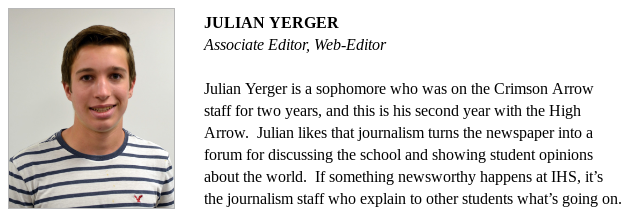By JULIAN YERGER – On March 23, 2018, 120 students from 11 regional high schools competed in the Physics Olympics, an annual math and science competition hosted by IUP undergraduates. A four-person team from Indiana won the spaghetti and tape tower building competition, but other schools won the jeopardy game, aptitude test, physics puzzles, and cumulative score competition.
IHS Senior Vince Birch was a member of one of the winning physics teams, and he attributed their success to earlier classroom instruction. “We just incorporated ideas that we had been learning all year into a more active environment where we were scored against other schools. All the activities pulled together concepts we learned in the classroom and this allowed the teams to be relatively successful.”
Nine IHS students organized into two teams and traveled to IUP, accompanied by Mr. Lehman. The trip left in the morning just after homeroom, joining students from ten other regional high schools: Bald Eagle, Bethlehem Center, Hollidaysburg Area High School, Leechburg Area High School, Moshannon Valley School District, Norwin High School, Penn Trafford, Trinity High School, United, and West Shamokin.
The first physics competition of the day was a general physics knowledge test with 20 multiple choice questions and three open-ended questions about Newtonian Mechanics, electricity, and magnetism. The test was followed by a Jeopardy game where team members could collaborate to answer the questions. Awards were given to the individual with the highest test score and the team with the highest score in the Jeopardy game. The IUP students running the Physics Olympics also weighted each competition against the others and kept a running team total for the overall winner to later be determined.
The group broke for lunch, which was pizza generously provided by the IUP Physics Club. This marked the beginning of the main competitions of the day, three hands-on physics experiments. First, each group was given 20 uncooked spaghetti noodles and one meter of tape to build a tower supporting the weight of one marshmallow.
Typical tower building competitions focus on tower height, but this one emphasized stiffness instead, measured in percent slump. If the tower is 10 inches tall without the marshmallow, then adding the marshmallow slumps the tower down to only 7.5 inches, that would be a 25% slump. While most groups focussed on building a conventional tower design, the team of IHS Junior Josh Mbogo decided to build something stouter. “The tower was shaped like a tetrahedral because that shape doesn’t bend at all. It was mostly Eddy’s idea; he thought of building a short tower.”
IHS Senior Edward Chandler was the first to realize that this competition had an unusual rulebook. “When I read the rules, I saw that neither the height nor weight mattered for the engineering challenge. Knowing that, I thought of the most stable structure I know of, which is a tetrahedron. It didn’t matter that it would take a relatively large amount of material to build one since that is all we needed to build.”
The group members are shown holding their triangular structure in the picture above, and this structure was so rigid that it had no measurable slump, so the group aced the rubric. However, another group built a slightly taller tower with no measurable slump, so they were awarded the first place award and the IHS team took second.
For the last two competitions of the day, students used principles of classical physics to predict the results of an experiment, then the prediction was compared to the actual result. The first of these competitions involved rolling a ball down a ramp and off a table, launching the ball into a cup on the floor. Students calculated the transformation of potential energy to kinetic energy and used this to find where the ball would hit the ground so that the cup could be placed there. The winning team predicted the result well enough for the ball to land in the cup and not knock it over.
The last competition involved a block sliding up a ramp attached by string to a falling weight and a pulley. Students had to calculate the amount of time it would take for the block to slide from the bottom of the ramp to the top, then the prediction was compared to the result. One of the IHS teams got close to predicting the correct value, but another team won this round.
The Physics Olympics will be held again next year when future teams from IHS can hope to defend their victories.

[Photo by Julian Yerger]
Photo caption: Seniors Vince Birch and Eddie Chandler, and juniors Andre Wassem and Josh Mbogo were enthusiastic participants in the Physics Olympics.

